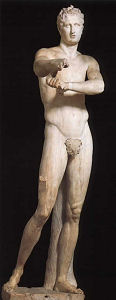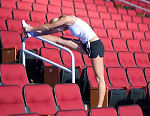Leg Definition - Patellar quad profusion
This is that teardrop shaped cut of muscle that appears above the
knee cap when standing. It's a bit different than most types of
definition, because it appears when relaxing.
This little detail of muscle definition appears on a lot of high
level athletes. Yet a lot of others don't have anything at all to show for their efforts.
At the same time, it occurs a lot among non-athletes, and even youngsters. This sort of random occurance is no surprise with a genetic-based detail. Even if a person has it, it can only be seen in certain poses, angles and lighting, and it can be hard to catch.
 The
Ancient Greeks noticed it and considered it the hallmark of
athleticism. They put it on all their statues. So did the Romans. We
have statues more than 2,300 years old that include that feature. In Renaissance
times, inclusion of this detail by artists such as Michaelangelo
contributed to the rebirth of lifelike art, with a posing technique
called contrapposto.
The
Ancient Greeks noticed it and considered it the hallmark of
athleticism. They put it on all their statues. So did the Romans. We
have statues more than 2,300 years old that include that feature. In Renaissance
times, inclusion of this detail by artists such as Michaelangelo
contributed to the rebirth of lifelike art, with a posing technique
called contrapposto.
Somehow throughout history, no term of reference ever stuck for this attractive body detail, or if it did, it did not make it down to us. Certainly it's noticed but names are random and vague: the teardrop cut, quad tips, knee roll, locked knee muscle, knee monster. I've dubbed it patellar quad profusion to at once denote the specific location, the muscle quality required, and hint at its conditional nature.
This classic detail is important in a detailed physique, so obviously you want it. Not everyone can have it. Who gets this classical definition, and who doesn't?
Well it seems to be associated with those whose knees can hyperextend (bend backward) a bit. When they stand with weight on the leg and lock that knee, the quad can relax, and if it is long enough, the extra length of the quad collects and appears as a roll of muscle overhanging the kneecap. It can also appear momentarily during walking, if the quad can relax as the knee moves past straight on the back leg.
The size of the patella or kneecap has a lot to do with it as well, in fact it is probably the most important factor. A large kneecap is likely to displace enough muscle mass to get the teardrop effect with no workout whatsoever.
With what workout can one acquire it, or improve it? Anatomically, it is the vastus medialis, an antagonist of the hamstring complex. Isolating it is very difficult, workouts that hit it usually include the entire quad complex, and in many athletes the overall quad will develop, hiding the desired teardrop look. Are there other ways?
Well, it seems to appear with great frequency among dancers as well as athletes. If active in youth, the characteristic can develop well before 10 years of age. Therefore, moves that stretch and lengthen out the quad should help. This would include squats and lunges. Take up dance or at least the stretching part. Work on muscle mass by simply being active. Other than that, this one is not to be worried about too much in the gym, as you either have it or you don't.
Dancer Stacy Keibler is a good example of this, therefore her workout should be studied.
PQP Gallery
At the same time, it occurs a lot among non-athletes, and even youngsters. This sort of random occurance is no surprise with a genetic-based detail. Even if a person has it, it can only be seen in certain poses, angles and lighting, and it can be hard to catch.
 The
Ancient Greeks noticed it and considered it the hallmark of
athleticism. They put it on all their statues. So did the Romans. We
have statues more than 2,300 years old that include that feature. In Renaissance
times, inclusion of this detail by artists such as Michaelangelo
contributed to the rebirth of lifelike art, with a posing technique
called contrapposto.
The
Ancient Greeks noticed it and considered it the hallmark of
athleticism. They put it on all their statues. So did the Romans. We
have statues more than 2,300 years old that include that feature. In Renaissance
times, inclusion of this detail by artists such as Michaelangelo
contributed to the rebirth of lifelike art, with a posing technique
called contrapposto. Somehow throughout history, no term of reference ever stuck for this attractive body detail, or if it did, it did not make it down to us. Certainly it's noticed but names are random and vague: the teardrop cut, quad tips, knee roll, locked knee muscle, knee monster. I've dubbed it patellar quad profusion to at once denote the specific location, the muscle quality required, and hint at its conditional nature.
This classic detail is important in a detailed physique, so obviously you want it. Not everyone can have it. Who gets this classical definition, and who doesn't?
Well it seems to be associated with those whose knees can hyperextend (bend backward) a bit. When they stand with weight on the leg and lock that knee, the quad can relax, and if it is long enough, the extra length of the quad collects and appears as a roll of muscle overhanging the kneecap. It can also appear momentarily during walking, if the quad can relax as the knee moves past straight on the back leg.
The size of the patella or kneecap has a lot to do with it as well, in fact it is probably the most important factor. A large kneecap is likely to displace enough muscle mass to get the teardrop effect with no workout whatsoever.
With what workout can one acquire it, or improve it? Anatomically, it is the vastus medialis, an antagonist of the hamstring complex. Isolating it is very difficult, workouts that hit it usually include the entire quad complex, and in many athletes the overall quad will develop, hiding the desired teardrop look. Are there other ways?
Well, it seems to appear with great frequency among dancers as well as athletes. If active in youth, the characteristic can develop well before 10 years of age. Therefore, moves that stretch and lengthen out the quad should help. This would include squats and lunges. Take up dance or at least the stretching part. Work on muscle mass by simply being active. Other than that, this one is not to be worried about too much in the gym, as you either have it or you don't.
Dancer Stacy Keibler is a good example of this, therefore her workout should be studied.
 |  |  |  |
| Leg stretching | Leg stretching | Quad stretch | Running stairs |
PQP Gallery
